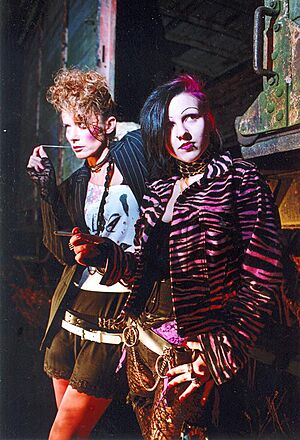Underground culture facts for kids
Underground culture describes groups of people who have different ideas or ways of living compared to what is common or popular in society. These groups might see themselves as unique, or others might see them that way. The word "underground" comes from the idea of secret groups that resisted harsh rulers in the past.
For example, the Underground Railroad was a secret network of routes. It helped African slaves in the 1800s escape to freedom. Later, in the 1960s, the term "underground railroad" was used again. It described a network that helped people who did not want to fight in the Vietnam War escape to Canada. It was also used for the secret movement of people and goods by the American Indian Movement in the 1970s.
Filmmaker Rosa von Praunheim showed the famous New York underground scene of the 1970s in some of his films. This scene was around Andy Warhol, a well-known artist. Since then, the term "underground" has been used for many different groups. These include mod culture, hippie culture, punk culture, techno music/rave culture, and underground hip hop.
What Does "Underground" Mean?
The simple term "The underground" was a common name for secret groups during World War II. These groups worked against the ruling powers. Later, this term was used for cultural movements that were different from the main society. Many of these movements appeared in the United States during the 1960s.
History of Underground Movements
The underground cultural movements of the 1960s and 1970s had some links to the Beat Generation. This group of writers and artists was inspired by French thinkers, artists, and poets. These French thinkers were part of the Existentialist movement in Paris after World War II.
Two famous French thinkers, Jean-Paul Sartre and Albert Camus, were part of a French resistance group called Combat. This group was formed in 1942. Sartre and Camus helped publish underground newspapers for the resistance. This French underground culture later inspired American writers like Jack Kerouac and Allen Ginsberg in the 1940s. Their ideas were often connected to socialist thinking before the Cold War began.
See also
 In Spanish: Cultura underground para niños
In Spanish: Cultura underground para niños
- Alternative culture
- Church of the SubGenius
- Counterculture
- Cult following
- Cyberpunk
- English underground
- History of subcultures in the 20th century
- Notes from Underground
- Neopaganism
- Prague Underground
- Soviet Nonconformist Art
- Ukrainian underground
- UK Underground
- Underground comix
- Underground film
- Underground Literary Alliance
- Underground music
- Underground press


